Abstract
This paper explores the concept of design for urban commons and its role in placemaking strategies that cater to community needs and aspirations. Placemaking is viewed as a collaborative process that involves early engagement with stakeholders to create shared visions. Design, particularly through co-design methodologies, scenario building and service design, can play a role in shaping public spaces for communal value and sustainability. This paper presents and discusses three case studies from Italy to introduce the concept of Service Master Planning, a methodology that combines co-design and service-centred scenarios to facilitate top-down actions that encourage bottom-up activation. It aims to co-create a vision for the future of a place involving the various actors of complex service ecosystems. Unlike traditional urban planning, which focuses mainly on the physical infrastructure, Service Master Planning emphasises services and social ecosystems. The methodology results in a strategic document, the Service Master Plan, outlining future scenarios based on contextual needs and aspirations. The successful adoption of Service Master Plan relies on inspiring spatial design and attracting community interest for co-producing the envisioned services. The challenge lies in transitioning scenarios into concrete actions, involving architectural and urban designers, and facilitating stakeholder consultations for service provision.
1. Vision, Social Infrastructure and Innovations
“Cities, like dreams, are made of desires and fears”, wrote Italo Calvino in his celebrated book ‘Invisible Cities’ in 1972 [1]. This poetic sentence poses a challenge to designers: to harness the power of desires and fears, transforming them into the very materials that build places, realising the life aspirations of those who dwell within. Thee are places that can foster the flourishing of communities, meaningful connections, and bottom-up activation.
In design research words, this turns into the recognition [2,3,4] of the fundamental role of bottom-up dynamics in creating community value through urban commons. Likewise, the transformative power of the collaboration of users in the design and implementation of public policies is acknowledged not only in the service design literature, but also in policymaking and public management research [5,6,7]. They both are preconditions for achieving sustainable places, namely, spaces that are meaningful for people, lived, vibrant, and creatively and intensively used by their inhabitants.
Limiting the observation to the Italian context, the key role of bottom-up factors, such as grassroots initiatives led by associations, local businesses, and self-organised groups, is widely acknowledged in urban transformation processes. They are pivotal to: re-think and re-use neglected or under-utilised public/private assets [8,9]; activate stakeholders and citizens to envision the future of communities and places, focusing on both the soft and hard infrastructure [10,11,12,13]; leverage cultural resources and innovation to trigger territorial transformations [14,15]; and prototype tactical actions to rethink and renovate portions of cities [16,17,18].
These initiatives have three characteristics in common: (1) the presence of a vision for the future and of a coordinating and steering ‘agent’; (2) the existence of an infrastructure of social connections (the social capital) available to take ownership of the initiatives; (3) the attempt to experiment with new forms of economic and social development, that is, with social innovations.
The three things are evidently connected: a vision could bind a community toward a common goal that can be achieved by acting together and collaborating through new organisational forms and solutions. Despite the seemingly smooth and linear consequentiality of these things, the process that can make them come into being and flow is not a one-size-fits-all solution, nor is it necessarily adopted into the governance of urban commons. Rather, a successful process to promote the co-production of urban commons in the public interest is likely to be the result of an interaction between bottom-up initiatives and top-down policies that could foster the abovementioned characteristics. Within this interaction, the ideation phase in which needs are turned into new service ideas is recognized as the most strategic and abductive one. It requires a well-guided exploration of varying combinations of problems, conditions, and solutions, and the involvement of different actors of complex service ecosystems. It assumes public policy to be “a means to enable service by coordinating multiple actors’ value cocreation activities to address public problems” [19] (p. 19).
What we discuss in this section is part of the broader concept of ‘placemaking’, which is at present being explored internationally with reference to several practices. This article aims to present and discuss a design approach to urban commons and placemaking, the Service Master Planning [2], which has the ambition to support a local ecosystem of actors and resources, led by a coordinating entity, in developing a vision for the future of a place, to create the conditions for effective stakeholder ownership and engagement in its co-production. Unlike traditional urban planning approaches that primarily focus on the physical infrastructure, spatial arrangements, and functions, Service Master Planning starts from services and activities that respond to people’s needs, values, and aspirations.
To articulate our thesis, we present and comment on three applied research case studies in which Service Master Planning, at different stages of its theoretical maturity, has been experimented.
2. Design for Placemaking and the Service Master Plan
Granata, in her book Placemaker [12], provocatively argues that architecture has long lost its role as society’s spur, its capacity for real transformation of places and ability to generate long-term visions. Conversely, she emphasises the role of the ‘placemaker’, who acts not only on the physical spaces, but on the behaviours, nature, feelings, and lifestyles too, using ‘imagination’ as an attitude that starts from reality and ‘sees beyond’, glimpsing connections and solutions and joining seemingly distant elements into new possibilities. Placemakers are not necessarily architects or policymakers, but ‘inventors of places’ that have the capacity to make things happen by elaborating upon people’s desires and fears to build a vision for the future.
Placemaking traces its roots back to the 1960s, when a debate emerged centred on the pioneering ideas of Jane Jacobs and William H. Whyte. They championed the notion of designing cities that prioritise people over cars and commercial centres. Their work revolved around the significance of lively neighbourhoods and inviting public spaces. Jacobs advocated for citizen involvement in street ownership, while Whyte underscored the elements required to nurture social vitality within public spaces [20].
We find it essential to emphasise one of the qualities of placemaking: the early engagement of the individuals who will inhabit and utilise a space in its design process. In the words of Whyte, this implies “looking at, listening to, and asking questions of the people who live, work, and play in a particular space, to discover their needs and aspirations. This information is then used to create a common vision for that place. The vision can evolve quickly into an implementation strategy, beginning with small-scale, do-able improvements that can immediately bring benefits to public spaces and the people who use them” [21] (p. 553).
We also recognize that placemaking is a transdisciplinary approach in which we feel it is relevant to focus the discussion on a couple of distinctive skills that design can bring to placemaking, namely, the co-design of scenarios and the service logic perspective. Indeed, co-design methodologies offer ways to consider different and opposing interests coexisting in complex systems, where a full alignment on visions is not always possible [22]. Accordingly, we can define placemaking as a collaborative design process through which we can shape our public realm by acting on its ‘soft’ infrastructural and intangible features to maximise communal value and sustainability and to configure, re-configure, and re-signify the space, so to transform it into a place that is meaningful for people.
Hence, design can contribute with a distinctive focus on people and their values, extending to include human interests in their interdependence with those of the larger terrestrial ecosystem to which we belong [23,24]. This approach emphasises the involvement of citizens and stakeholders in placemaking, according to an idea that has emerged in many examples worldwide of bottom-up and multi-stakeholder collaboration in urban planning, spatial organisation, city development, and the reconfigurations of public spaces and services. Within this variety, collaborative scenario design is a recurring approach. In strategic design, this involves formulating future narratives through a combination of storytelling and visual elements, drawing from multiple disciplines. These narratives, referred to as ‘plots’ by Ogilvy [25], incorporate factors, forces, and values that shape potential outcomes. Manzini and Jégou [26] developed the methodology of ‘DOS—Design Orienting Scenarios’, which consists in creating a set of visions for the future that are motivated, illustrated, and visualised through specific solutions, representing different perspectives to an issue. Hence, scenarios in design are visions materialised and exemplified through practical and specific proposals.
Scenarios may be crafted around collective values and the so-called ‘service logic’, that is, the re-conceptualization of products and spaces in view of the services they can enable. In the words of Vargo and Lush [27], services are a perspective on value creation rather than a value added to things, and their value is always co-created with the beneficiary. The culture, knowledge, and capacities of people and contexts thus become integral parts of what services provide, of the way they operate and can enable (or not) a group of actors to co-design, co-produce, and exchange value within given contexts. When it comes to designing urban commons, this shift in perspective turns into the design of scenarios of interactions and relationships among stakeholders as complementary, or better, anticipatory of the design of the physical space. In other words, the emphasis is placed on envisioning how people will interact and relate within the space so that these social dynamics can be given priority when planning the physical layout of commons. We assume this priority in the design focus to be key to infrastructuring the social connections [28] that can engage stakeholder and users to take collective ownership of commons.
Accordingly, the governance of the interplay between top-down policies and bottom-up forces is key for stakeholder engagement.
Top-down planning strategies are employed by public governments and urban developers to envision, design, and regulate the development of a specific location or area. The use of ‘master plan’ narratives, since the 1950s, has referred to the coherency of the urban form of the built environment and its developmental process with the functional necessities of the city [29]. In this same vein, the theoretical paradigm of ‘comprehensive planning’ emerged as a rational problem-solving and decision-making process, envisioning the city as a singular and unchanging entity. Over time, this paradigm has evolved, gradually incorporating principles of sustainability, inclusivity, and public participation, thereby enhancing its responsiveness to diverse urban challenges [30,31]. In other words, today, the top-down policy of a ‘master plan’ recognizes the engagement of stakeholders and users as a value and a needed pre-condition to design and implement urban plans that are effective and sustainable.
Bottom-up practices in urban planning encompass a range of initiatives driven by citizens, grassroots organisations, and creative communities. They are aimed at effecting positive changes in the urban environment to better respond to the needs and aspirations of the people inhabiting it. They can be seen as social innovations that make alternative and creative uses of spaces for initiatives aimed at solving everyday problems, affording priority to relationship and collaboration. They are tactical actions that experiment with collaborative activity models. Examples range from guerrilla gardening to alternative mobility solutions, from neighbours’ convivial feasts to improvised playgrounds, and much more [32], or to address concerns related to unsuccessful or controversial situations with a critical design approach [33]. In a recent essay, Manzini, Fuster, and Paez [34] refer to ‘plugs-in’, that is, engendering practices that generate transformations in the urban ecosystem “with the intention of giving what one would like to see happen a greater chance of existing, thriving and lasting over time” (p. 243). This may take place in a critical stance with the larger system of top-down planning and policy and generate outcomes that could create new configurations for the whole.
This way in which people think and act is also defined as commoning [35], a concept that is deeply rooted in volunteerism, political engagement, intrinsic motivation, visionary thinking, and sense of belonging. Commoning is transforming the way commons, including public spaces, are perceived and defined. Likewise, social innovation achieves its purpose of meeting social needs and creating public value through practices and also via the collaborative design process they imply.
Based on these principles, we progressively elaborated, through the case studies presented below, the idea of Service Master Planning [2] as a conceptual construct and a tool that can bring about a Service Master Plan. Its purpose is to combine, in a consistent output, the engaging potential of co-design with the visionary influence of service-centred scenarios, so to facilitate top-down actions that encourage bottom-up activation.
It represents the completion of a process that seeks to integrate collaborative scenario building with the involvement of a place-based social infrastructure and the creation of conditions conducive to social innovation. Therefore, the methodology of Service Master Planning integrates different approaches and strategies of collaborative placemaking in a process driven by service logic, which prioritises the systemic design of place-based relations over the one of functions and spaces.
3. Case Studies
In this section, we introduce three case studies from the research group of the authors, the Polimi DESIS Lab of the Design Department of Politecnico di Milano. They differ in duration (from about 4 months to 2 years), type of client (the public sector or real estate developers), involvement of design researchers and/or students, and stakeholder and/or citizen engagement. Following a modus operandi that qualifies the research Lab, applied research projects often involve Master’s-level design students from the School of Design, in a consolidated, beneficiary mutual relationship of educational and research activities. In fact, in higher education, it is common practice to confront students with real cases, issues, and challenges in studio settings, that is, in problem-based and problem-solving contexts in which they work in a team and have a dialogical interaction with teachers. When it comes to Master’s-level students, their contributions prove to be particularly valuable and critically relevant to project-based activities.
All cases are situated in Italy and share a starting point: a designated area already undergoing urban master plan transformations yet urging the development of a distinctive vision and of specific service solutions to better orient, define, and integrate the related spatial design.
The projects are presented through phases that are explained later in this paper as part of the Service Master Planning process: they are inspired by the well-known Double Diamond methodology [36], which starts with a phase of discovery and research, then a generative phase for finding ideas enriched by co-design workshops, and finally a development phase with prototyping activities. Although named differently, the phases and logic of Double Diamond inform the methodology used in the case studies, as we will discuss better with reference to the Service Master Planning process.
3.1. Rival(u)ta Rivalta in Reggio Emilia
‘Rival(u)ta Rivalta’ (which can be translated as ‘Re-value Rivalta’) is the project we delivered for the Municipality of Reggio Emilia, as part of the Ducato Estense development financed and promoted by the Italian Ministry of Cultural Heritage. The objective was to envision the future of the Reggio Emilia Ducal Palace, with a specific focus on its park—a vast public space situated in the suburb of Rivalta.
Rival(u)ta Rivalta was designed as a process of 4 main phases conducted between 2018 and 2019: a series of co-design workshops with stakeholders that were selected and invited by the Municipality to offer an expert contribution in their role. Each of them, in fact, brought the perspective of a different category of stakeholders, ranging from cultural operators to general services suppliers, from third-sector associations to sport circles, and others. Residents were not included, because they were already consulted through ‘Citizenship Workshops’ and ‘Urban Laboratories’. The results were enclosed in a report to inform an international landscape design competition launched concurrently. After the competition’s winners were selected, we involved them in further co-design activities to converge on a cohesive spatial and service scenario. This scenario, formulated as a Service Master Plan, served as the foundation for the subsequent implementation phase.
The following is a brief description of the 4 phases:
- Scoping: It consisted of a series of meetings with Reggio Emilia policymakers, which made it possible to understand, share, and interpret their guiding vision for the area. Policymakers had already a broad idea of the future of Rivalta: as researchers, our contribution was to enhance and enrich that idea by identifying the design principles that best captured the essence of the ‘genius loci’. A guiding vision emerged: to consider the ducal complex as a place with different ‘identities’ catering to its multiple beneficiaries, from the more local (the resident of the Rivalta neighbourhood) to the inhabitants of Reggio Emilia to national and international visitors. The fil rouge linking these identities was identified by policymakers as a strong ‘natural’ character: the park was to be a green oasis within the city, and this was the main recommendation that informed our work throughout the process.
- Generative listening: Policymakers selected 26 local stakeholders to be consulted from among the most active and prominent actors in the cultural and associative life of the city, as well as experts in technical sectors. Some members of the council of the city were additionally selected for an interview, such as councillors and the mayor. Interviews were organised as interactive conversations, guiding people not only to provide information, but also to express desires and elaborate visions. The output of this phase was a ‘sensible collection of insights’ that created the basis to guide the subsequent co-design workshops.
- Co-design workshops: We conducted 5 workshops with 42 people (Figure 1), some of them were participants of the first phase and others were new relevant stakeholders from local institutions, companies, universities, and associations. Building upon the results of the previous phase, we elaborated a conceptual map displaying 4 main design directions: printed on a large board, this map served as a physical and conceptual support for the co-design activities. Furthermore, we devised a deck of cards depicting potential services and activities. These ideas were sourced from a preliminary study of existing case studies and categorised based on the 4 directions of the map. Every participant was encouraged to choose services from the deck of cards, and by combining these selected activities, they formed their own personalised vision for the future of Rivalta’s complex. Those visions were then positioned on the map and discussed collectively. As a final stage, participants were paired according to the link between their visions and invited to use a stakeholder map to think about the actors involved and/or impacted by their future vision. At the end of the 5 co-design workshops, we collected 42 personal visions and 21 stakeholder maps. After an extensive work of re-elaboration, we delivered a first set of 6 scenarios, presented as stories about possible futures, proposing new ways of doing and living in the park. The scenarios were intended to steer, yet very openly, the spatial project and were thus integrated into the brief for the landscape design competition.
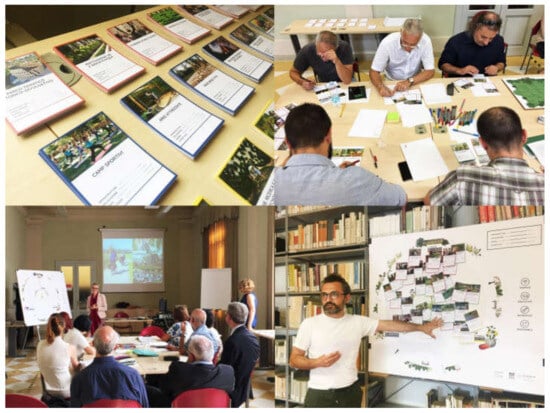 Figure 1. Co-design workshops during the Rival(u)ta Rivalta project (pictures by the authors).
Figure 1. Co-design workshops during the Rival(u)ta Rivalta project (pictures by the authors). - Integration into the spatial design: In the last phase, we worked with the winners of the international competition. In the spatial project developed by the team of Openfabric, Casana, and F&M Ingegneria, the evidence of the incorporation of parts of the 6 scenarios is clear: the revisited attention to the historical memory, the focus on circular processes and sustainability, the variegated areas for bottom-up initiatives, the several hot spots for sport, wellbeing and inclusion, and many more. The team, eventually, participated in a co-design workshop with us to combine the spatial and service features into a consistent whole. Beforehand, we condensed the 6 scenarios into the 2 most cohesive ones aligned with the landscape project: the workshop was then built around a service design tool known as offering map to integrate the proposed layout with the envisioned services. In so doing, we delineated the primary and secondary offering (the core services and the additional ones to be provided within the Ducal complex) and all services were associated with specific areas of the space (Figure 2).
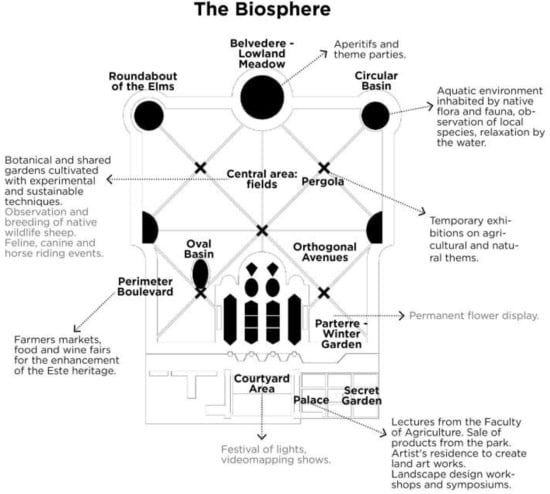 Figure 2. Situated offering map of ‘The Biosphere’ scenario (layout map © Openfabric).
Figure 2. Situated offering map of ‘The Biosphere’ scenario (layout map © Openfabric).
The final output consisted of 2 scenarios shaping a Service Master Plan: ‘The Wellbeing Park’ that elaborates the themes of health and living well, and ‘The Biosphere’ that refers to the themes of landscape, nature, and harmony with the surrounding environment (Figure 3). After 4 years, the Reggio Emilia Municipality is, at present managing the final development of the project, building upon a combination of elements of the 2 scenarios, and is planning a follow-up to the participatory process to envision the place’s governance.
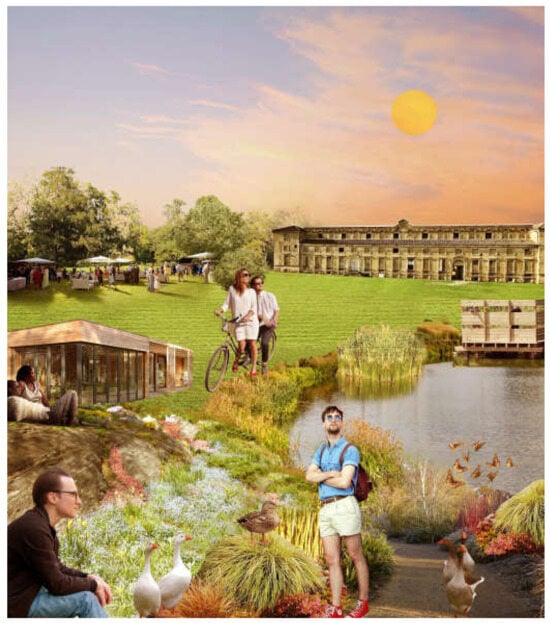
Figure 3.
A visualisation of ‘The Biosphere’ scenario (picture by the authors).
3.2. MilanoSesto
‘The Responsible City’ is the title of a service design studio of the Master of Science programme in Product-Service System Design at the School of Design of Politecnico di Milano, which we taught in 2019. It involved around 50 international students of the most advanced Master’s design class in the ‘MilanoSesto’ project: a redevelopment effort of the former industrial area of the Falck Industrial Complex in Sesto San Giovanni, bordering Milan. The theme was thus chosen as a topic for the applied studio to provide students with a real case and to simulate, for the client, the work of a creative design research and applied consultancy.
The MilanoSesto project, which has been years in the making, plans to include multiple buildings for dwelling, work, leisure, and hospitality, as well as a large green area that connects all the functions. At the heart of the project, there is a healthcare centre, named ‘La Città della Salute e della Ricerca’ (that can be translated as the ‘City of Health and Research’), to where some of the main hospitals of Milan will be transferred. It is one of the biggest urban regeneration projects in Europe, covering an area of 1.45 million square metres, originally developed by MilanoSesto Developments and two big real estate companies, Hines and Prelios.
The challenge was to look at this urban development from the perspective of the services that the area could offer: a Service Master Plan for a ‘responsible city’ came out as combination of 12 possible new services, each one ideally delivered by a start-up.
The studio, lasting 4 months, went through 6 main phases.
- Research: This included an in-depth exploration of the site and the development plan, an investigation of the existing urban developments for inspiration, and a set of interviews with experts, stakeholders (identified by MilanoSesto Devolopments), and citizens. In addition, the students were asked to explore the existing services by providing a case study analysis in different areas. Output: a research report for each identified service area.
- Design of the Service Master Plan: The students critically organised the need areas that emerged from the research phase to create a comprehensive plan for future services and solutions. The output was a collective document organised into different classes of services, which were defined following the most updated version of the Nice Classification (NCL), established by the Nice Agreement [37]. This is an international classification of goods and services applied for the registration of marks. According to this classification, the students identified promising opportunity areas for each class of service by describing the following elements: a vision to be achieved for the general benefit of society; the main users of the services; possible impacts (on public space, natural capital, time, and scalability, risks); requirements (of space, urban infrastructure, natural/non-natural resources, technologies, touch-points, rules, and regulations); and actors (stakeholders, PA, and citizens).
- Concept generation: The Service Master Plan became the brief for the students’ projects. Building upon it and considering a set of design principles that we identified as fundamental for the services to be provided in a responsible city, the students ideated 12 concepts in different need areas.
- Co-design: A series of co-design workshops were then conducted involving local stakeholders, citizens, and experts, to enrich and expand the service concepts. They addressed several need areas and desires, such as encouraging commerce and entrepreneurship, supporting distributed healthcare, enjoying sustainable food, providing permanent and temporary housing, working with flexibility, rethinking logistics, producing and consuming within a circular economy, commuting and moving, defending biodiversity, managing energy resources, and organising citizen collaboration. The output of this phase was a set of advanced service ideas.
- Service development: A full development of the solution from all perspectives, i.e., the product-service system offering, the user experience, the front and backstage, the touch-points, the spatial/urban requirements, the impact measurement and indicators, the stakeholder engagement, and the business model and plan. The output of this phase was 12 innovative service start-ups.
- Prototyping: A ‘Fair of Future Businesses for MilanoSesto’ was designed and held in January 2020 at the Spazio MIL in Sesto San Giovanni (Figure 4), where the imagined start-ups were presented and discussed with mentors, experts, and citizens. At this Fair, each group of students prototyped their service venture in a dedicated stall, showing the most relevant elements of their solutions and providing additional information to visitors. The management team of MilanoSesto awarded a prize to 3 of the projects, which were selected for their visionary power, considerable humanity, and pragmatic approach.
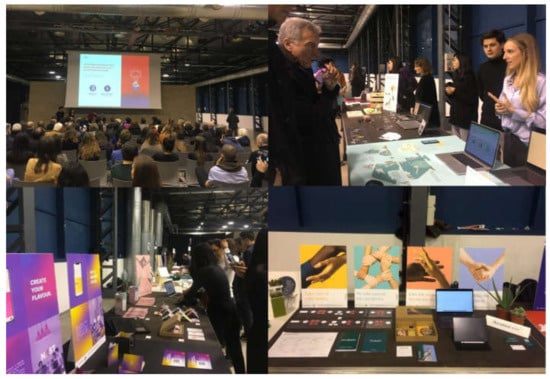 Figure 4. The ‘Fair of Future Businesses for MilanoSesto’ (pictures by the authors).
Figure 4. The ‘Fair of Future Businesses for MilanoSesto’ (pictures by the authors).
Among the awarded ideas were ‘Arcadia’, a solution providing a set of tools and spaces to enable a relation between humans and nature for the transition to a post-anthropocentric city (Figure 5); ‘Wecare’, a community of caregivers in which every citizen can become a caregiver with the proper support, being rewarded with caring in the future; ‘Sinergia’, a virtual energy trainer that not only tracks personal energy usage, but also introduces a rewarding program and encourages people to engage in community growing.
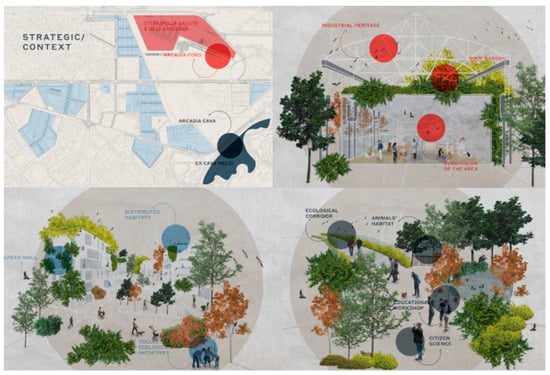
Figure 5.
Pictures from the ‘Arcadia’ project (students: G. Amendolaggine, A. Dell’Oro, M. Polo, and C. Yang).
At present, works are underway for the construction of the new MilanoSesto district, which will be completed after 2032. The work of our students, developed right before the COVID-19 pandemic, attempted to be an inspirational guide for the activities to be provided in the area. Above all, it provided a vision, gently nudging the developers to start considering not only spaces and cubic metres, but also services having specific features and time ranges.
3.3. Tourist Harbour Carlo Riva in Rapallo
‘Design of future scenarios for the Tourist Harbour Carlo Riva’ is the title of a didactic activity that we conducted at the School of Design of Politecnico di Milano, involving a group of 20 international students selected through a call-for-submissions (based of their CV and portfolio) from 3 different Master’s degrees programmes (Product-Service System Design, Interior and Spatial Design, and Naval and Nautical Design).
The goal of the initiative, commissioned by Bizzi & Partners, a global real estate development company, was to elaborate a set of future scenarios for a Service Master Plan to be implemented in the tourist harbour ‘Carlo Riva’ in Rapallo, the most important private Italian marina, damaged after a sea storm in 2018 and to be completely rebuilt, re-branded, and managed. The architectural design firm Tectoo already developed an urban master plan to restore the safety conditions of the sea defence and reconstruct the marina.
The design activities were framed as a design contest: the group of students was created after a selection process and included them in an extensive workshop, conducted from March to May 2022. It was split into three main phases guided by teachers: research, concept generation, and the development of future service scenarios.
- Research: The students conducted a field study in Rapallo, visiting the area, which has been closed since 2018 (Figure 6). The design brief they received was to create a ‘high-end harbour’, a marina providing the most complete and updated range of services that could characterise an efficient and pleasant future destination, considering environmental and social sustainability as the basis of the whole project. The main goal was the involvement of the local community: despite the primary users of the harbour being tourists, the brief equally considered the Rapallo residents as recipients of the services and beneficiaries of the harbour. Some of them were identified as available for consultation by Bizzi & Partners and were indeed interviewed by students. The brief was complemented by the provision of a set of contextual opportunities, elaborated from a preliminary analysis of global trends and field research: sport, tourism and hospitality, design, and cultural and natural heritage. The output of this phase was a report of each of these opportunities.
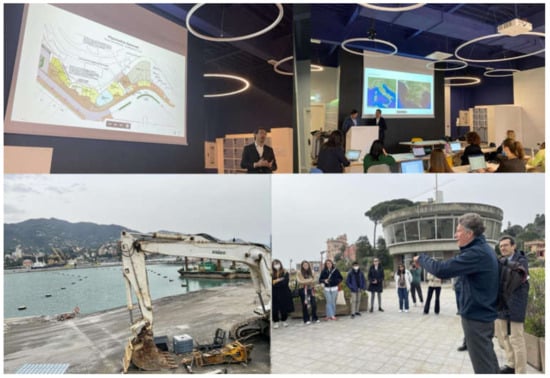 Figure 6. Photos from the workshop and the field study in Rapallo (pictures by the authors).
Figure 6. Photos from the workshop and the field study in Rapallo (pictures by the authors). - Concept generation: The students were engaged in a brainstorming to generate as many ideas as possible. The outputs of this phase were a series of ‘draft scenarios’ to be selected and continued in the following step.
- Development of future service scenarios: The students built four specific scenarios, defining the primary and secondary offering of services, elaborating user journeys, and touchpoint and stakeholder maps to provide all the necessary elements to frame the possible future(s) of the harbour. A public presentation was organised in the Municipality of Rapallo in the presence of the mayor of the city and together with the developer, Bizzi & Partners. The output of this phase was a Service Master Plan comprising the four aforementioned scenarios.
More in detail, the scenarios shaping the Service Master Plan were: (1) ‘The Harbour of Amusement’ was centred on the idea of ‘sportainment’ adventure, combining sports, entertainment, and recreational activities (Figure 7 and Figure 8); (2) ‘Europe’s Leading Carbon-negative Marina’ aimed to set a new standard for sustainable marinas; (3) ‘Design Bay’ aspired to transform the marina into a hub of nautical design; and (4) ‘The Floating Resort of Rapallo’ combined sea and land tourism, building a destination suitable both for work and vacation.
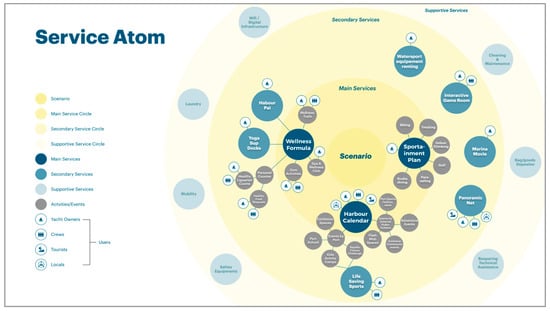
Figure 7.
Offering map of ‘The Harbour of Amusement’ scenario (students: A. Bosso, G. Musumeci, A. Panzetti, and D. Perera).
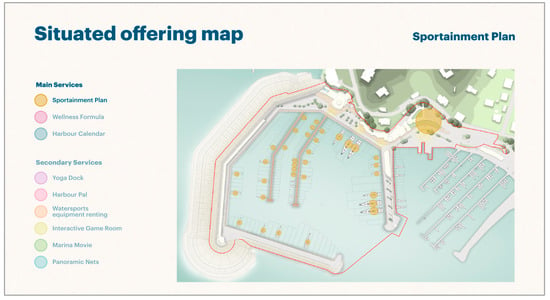
Figure 8.
Situated offering map of ‘The Harbour of Amusement’ scenario (students: A. Bosso, G. Musumeci, A. Panzetti, and D. Perera).
These scenarios were meant to be a stimulus for the executive project, each of them showing potential elements that, selected and combined in the most appropriate way for Rapallo and its context, could support the development of an innovative and, as was the intention, cutting-edge harbour in Italy and the rest of the Mediterranean. At present, works are underway conducted by Bizzi & Partners.
3.4. The Service Master Planning Process in the Case Studies
We streamlined, packed up, and named as ‘Service Master Planning’ the working methodology of service design applied to urban commons (Figure 9), echoing the idea of commoning. It can be considered as an evolution of the aforementioned Double Diamond methodology [37] and as a design-thinking activity for placemaking. Defined by a sequence of macro-activities focused on understanding and designing, this approach involves design and policy decisions made collaboratively with the main stakeholders, influenced by inputs gathered from the broader community.
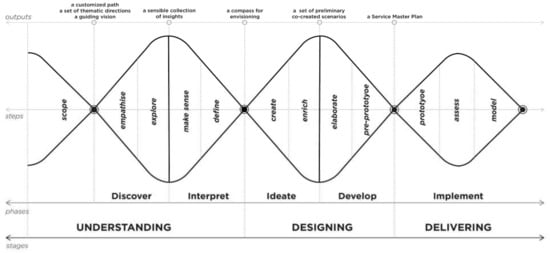
Figure 9.
The Service Master Planning process (scheme by the authors originally published in their book Service Design for Urban Commons [2]).
In Table 1, we compare the three case studies based on the common phases that shape the Service Master Planning methodology, which involve an iterative process of divergent and convergent thinking. This approach facilitates a continuous analysis and synthesis of the problem at hand. Divergent thinking enables the creative exploration of various options, values, services, and activities, generating inputs to be considered in the planning process. Convergent thinking ensures that policy decisions are appropriately guided and acknowledged based on analysis and the creative inputs.

Table 1.
The Service Master Planning phases in the 3 case studies.
The initial Scope phase allows the alignment of the diverse interests and actors: it is a set of conversations to prompt the entire process, ensuring the accomplishment of Service Master Planning and setting expectations for the results. Specifically for this phase, we point out a difference that we experienced while conducting scoping activities with the public sector in comparison with the private one. In the Rival(u)ta Rivalta case study, our work consisted in building upon an existing value-informed vision, trying to expand it, to explore new possible directions within the main strategy defined by the policymakers. Conversely, the two real estate companies came with project visions that were mainly concerned with functionalist, hard/infrastructural features. Thus, they expressed the need to question and think about the very idea of the city and place they wanted to achieve. Our university team, offering an expertise that combines creativity with a design approach focused on social and environmental sustainability, was thus engaged to support this process. The projects of MilanoSesto and Rapallo were aimed at re-thinking a vision and focused on values and soft features: both companies had already developed the urban master-plans and were looking for a sense-making process to populate spaces with activities and services. Thus, they were even open to negotiating changes in their plans.
The Discover phase is a divergent exploratory activity conducted through field research, understanding the context and empathising with the parts involved.
The following Interpret phase implies a convergent thinking process: it is a reflection that ‘connects the dots’ and provides a range of directions to guide the following steps.
In the Ideate phase, concepts are collaboratively generated and further enriched by seeking input from a diverse group of actors that are familiar with a specific issue. This approach expands the design options thanks to contributions from various perspectives. In this phase, co-created preliminary visions and scenarios are created.
The Develop phase converges around the elaboration of a selection of service scenarios, framed in reference to a possible spatial layout.
These activities mark the completion of the design phase and generate the Service Master Plan. Following this, the implementation focuses on putting the plan’s strategies into action, in a continuum of interaction with stakeholders: in the three cases presented, this is still ongoing. It is crucial for the process to be adapted to and adopted by each specific context, which have unique rules and requirements.
Being at the origin of the process that led to the development of the Service Master Planning methodology, the three presented case studies apply it differently, partially, and inconsistently. Yet, they share the relevance of the co-creation of a vision for the future, which is initially discussed in the Scope phase and then re-framed in the Interpret, Ideate, and Develop phases, until the final scenarios are shaped. We elaborated more than one scenario per case, each one describing the features of a place and its services as a coherent whole in a future time. The significance of having a set of scenarios, as opposed to a single-point forecast, lies in the robustness it offers to the decision-making process. In fact, according to Ogilvy [25], we understand that imaging strategies for a range of futures, rather than only one, allows one to “see whether there are some options that are robust across the range of scenarios” (p. 77) and that can engage and activate communities and stakeholders.
Hence, the overall aim of Service Master Planning is to co-design the basis from which placemaking projects that address urban commons can be implemented: it results in a strategic document (the Service Master Plan) that describes alternative scenarios of activities and services that might take shape in a given place and time. It streamlines the involvement of public administrations, stakeholders, civic organisations, and citizens in bringing to life initiatives that align with a shared strategy and are collaboratively produced and managed. It is, in fact, proven [12,38] that the social, economic, and environmental sustainability of new urban developments or redevelopment is connected to this top-down and bottom-up alignment of visions and intentions. This is recognised to be a precondition for creating common value, that is, a shared interest for all parties, and for having spaces, buildings, infrastructures, and assets that make sense for people and are lived.
4. Conclusions: From the Service Master Planning Process to Implementation
The distinctive feature of the Service Master Planning process as a design-driven placemaking approach lies in its emphasis on combining service design with scenario building and co-design processes to outline the places, services, and the community that may inhabit them.
It is not a completely new methodology, but a process that systematically reverses the perspective to urban planning by adopting and adapting a placemaking approach, recognised at present for its value and by expanding it through the lens of service design. In product design, this reversed perspective is well-known and is ascribed to the aforementioned ‘service logic’, which is a systematic way of rethinking hard products in the view of the service that they can deliver to achieve user satisfaction and sustainability. We believe that the approach of Service Master Planning is a way to make this reversed logic more systematic and conscious, to complement the urban planning one. We also believe, supported by the literature [39,40], that a service logic, namely, a logic that values accessibility over ownership, transformability and adaptability over mass customisation, and collective ownership over individual use, could be more effective towards sustainability than a simple spatial planning logic.
Service Master Planning considers places as social and service ecosystems [27] where interactions, relationships, and services play a vital role. By integrating divergent and convergent thinking, the methodology fosters sequences of analytical and synthetical thinking, allowing for the creative exploration of multiple possibilities and the alignment of policy decisions with the identified needs and desires. This iterative process is materialised as scenarios and enables the plan to be adaptable and contextually relevant, bringing about its effective adoption by the local actors and the responsiveness to the specific characteristics of each location.
In doing so, it aims to make the flow of decisions and policies that transform visions into experimentations more fluid and coherent. Indeed, its challenge is to make collective creativity and participation distinctive elements of the subsequent prototyping phase as well, and thus of the activities it outlines. This assumes that it can create the conditions to experiment with innovative forms of economic and social development. The co-production and co-management of services can be considered distinctive features of these forms, if we understand them as possible social innovations whose ownership can be taken over by the actors who participated in the Service Master Planning process.
From our perspective, thus, a Service Master Plan holds the potential to serve as a strategic document that frames future commoning strategies and tactical bottom-up initiatives on urban commons. Its proof of concept lies in the power to not only inspire the spatial design of the area, but also to generate community interest in initiating such initiatives and actively participating in the co-production of envisioned services. Hence, the methodology offers pathways to transition from scenarios to implementation, contemplating both the design of physical spaces, which necessitates the integration of expertise from architectural, urban, or landscape designers and the identification and engagement of actors who will contribute to the co-production of the services in the space. Despite not yet having evidence of this, we infer that Service Master Planning, as a guided decision making and collective process, may aid in the prevention and management of the conflicts that could arise among actors during the design of a place.
Drawing from the presented case studies, we understood that it is not a process designed to ‘please’ everyone. In fact, the objective of inclusivity does not imply incorporating every single opinion when building scenarios: such an approach may not yield the best results but a ‘grey’ output instead, poor in quality and identity because of the forced combination of different perspectives. On the contrary, Service Master Planning offers a creative and transparent way to deal with them, and we crafted it as an ‘agonistic’ process, in line with Mouffe’s perspective [41]: a political approach that allows controversies to coexist side by side, rather than seeking to negotiate them into a consensus. It acts as a mise en scène of agonism, where future interventions are conceived and discussed interactively, fostering a multi-voiced narrative that lays the groundwork for a place’s future identity.
Hence, we acknowledge that the most considerable limitation of the study is the difficulty to measure the impact of the methodology on the implementation of the projects, which require relatively long time. The observation of the project implementation will, thus, inform our next research. If we consider an indicator of the impact whether the Service Master Planning enables a more participated, effective, and sustainable taking action of the community on the new space (a process of identification), we clearly do not yet have outcomes. However, to provide a foundation for our belief that this positive impact can occur, we draw upon the aforementioned Mouffe’s agonistic theory and Illich’s conviviality theory [41,42], which specifically emphasises the dynamic between individual freedom and collective interdependence, manifested in creative interactions and enabling people to create the environments in which they can thrive.
Finally, we suggest Service Master Planning to be a way to exercise collaborative governance between top-down policies and bottom-up efforts. It is a political act with political implications, including changes in the relationship between policymakers, stakeholders, and citizens, because it opens forms of political participation and political possibilities. More than being a collection of solution-making methods and practices for urban challenges, Service Master Planning is intended to generate a political vision: a co-created future for a place and the pathway to achieve it. It aims to empower a community to practise political agency within a context riddled with conflicts, acknowledging that not every problem may have a straightforward solution, while a sense-making activity—as Service Master Planning is—could at least provide a range of possible answers.
Author Contributions
All authors participated in equal manner to the research and the definition of the article, yet paragraphs 1 and 2 were written by A.M., paragraphs 3 and 4 by D.S. All authors have read and agreed to the published version of the manuscript.
Funding
This research received external funding from the entities mentioned in the case studies of the article.
Informed Consent Statement
Inform consent was obtained from all subjects involved in the study.
Data Availability Statement
Data are contained withing the article.
Acknowledgments
We thank our colleagues from POLIMI DESIS Lab: Marta Corubolo, Chiara Galeazzi, Martina Rossi, Stefana Broadbent, and Marta Carrera for their precious help in the Rival(u)ta Rivalta, MilanoSesto, and Rapallo projects. We also thank the Municipality of Reggio Emilia, MilanoSesto, and Bizzi & Partners for having provided us with the possibility to conduct our research activities and experiment using the Service Master Planning methodology.
Conflicts of Interest
The authors declare no conflict of interest.
References
- Calvino, I. Le Città Invisibili; Feltrinelli: Milan, Italy, 1972. [Google Scholar]
- Meroni, A.; Selloni, D. Service Design for Urban Commons; SpringerBriefs: Berlin/Heidelberg, Germany, 2022. [Google Scholar]
- Huybrechtsa, L.; Beneschb, H.; Geib, J. Institutioning: Participatory Design, Co-Design and the public realm. CoDesign 2017, 13, 148–159. [Google Scholar] [CrossRef]
- Seravalli, A.; Eriksen, M.A. Beyond Collaborative Services: Service Design for Sharing and Collaboration as a Matter of Commons and Infrastructuring. In Designing for Service: Key Issues and New Directions; Sangiorgi, D., Prendiville, A., Eds.; Bloomsbury Press: London, UK, 2017; pp. 237–250. [Google Scholar]
- Trischler, J.; Dietrich, T.; Rundle-Thiele, S. Co-design: From Expert to User-driven Ideas in Public Service Design. Public Manag. Rev. 2019, 21, 1595–1619. [Google Scholar] [CrossRef]
- Foglieni, F.; Villari, B.; Maffei, S. Designing Better Services. A Strategic Approach from Design to Evaluation; SpringerBriefs: Berlin/Heidelberg, Germany, 2018. [Google Scholar]
- Selloni, D. CoDesign for Public-Interest Services. Research for Development Series; Springer International Publishing: Berlin/Heidelberg, Germany, 2017. [Google Scholar]
- Fassi, D.; Vergani, F. Designing Solutions for the Commons. In Sustainability Awareness and Green Information Technologies; Issa, T., Issa, T., Issa, T.B., Isaias, P., Eds.; Springer Nature: Cham, Switzerland, 2020; pp. 463–477. [Google Scholar]
- Mangialardo, A.; Micelli, E. From Sources of Financial Value to Commons: Emerging Policies for Enhancing Public Real-estate Assets in Italy. Reg. Sci. 2018, 97, 1397–1408. [Google Scholar] [CrossRef]
- De Rosa, A.L.; Auricchio, V.; Monna, V. SMOTIES: Scenario-Building for Creative Future Solutions in Remote Places. In Proceedings of the Conference ServDes.2023—Entanglements and Flows, Rio de Janeiro, Brazil, 11–14 July 2023. [Google Scholar]
- Niessen, B. Abitare il Vortice. Come le Città Hanno Perduto il Senso e Come Fare per Ritrovarlo; UTET: Torino, Italy, 2023. [Google Scholar]
- Granata, E. Placemaker. Gli Inventori dei Luoghi che Abiteremo; Einaudi: Torino, Italy, 2021. [Google Scholar]
- Ferri, G. Starting Up Communities: A Design-kit for Collaborative Housing; Pearson Italia: Milano/Torino, Italy, 2016. [Google Scholar]
- Colombi, C.; Penati, A. Social Innovation Fostering Cultural Sustainability. In Fashioning Social & Cultural Innovation; Vacca, F., Ed.; Mandragora: Firenze, Italy, 2021; pp. 15–21. [Google Scholar]
- Tricarico, L.; Jones, Z.M.; Daldanise, G. Platform Spaces: When culture and the arts intersect territorial development and social innovation, a view from the Italian context. J. Urban Aff. 2022, 44, 545–566. [Google Scholar] [CrossRef]
- Foglieni, F.; Leoni, F.; Cipriani, L.; Maffei, S. From Ideas to Policies, Through Places: Service Design-Driven Prototyping Guidelines for Urban Regeneration. In Proceedings of the Conference ServDes.2023—Entanglements and Flows, Rio de Janeiro, Brazil, 11–14 July 2023. [Google Scholar]
- Fassi, D.; Manzini, E. Project-based Communities: Lessons Learned from Collaborative City-making Experiences. CoDesign 2021, 18, 4–15. [Google Scholar] [CrossRef]
- Silva, P. Tactical Urbanism: Towards an Evolutionary Planning Approach? Environ. Plan. B Plan. Des. 2016, 43, 1040–1051. [Google Scholar] [CrossRef]
- Trischler, J.; Charles, M. The Application of a Service Ecosystems Lens to Public Policy Analysis and Design: Exploring the Frontiers. J. Public Policy Mark. 2019, 38, 19–35. [Google Scholar] [CrossRef]
- LeGates, R.T.; Frederic Stout, F. (Eds.) . The City Reader; Taylor and Francis: Abingdon, UK, 2020. [Google Scholar]
- Whyte, W.H. The Design of Spaces. In The City Reader; LeGates, R.T., Frederic Stout, F., Eds.; Taylor and Francis: Abingdon, UK, 2020; p. 553. [Google Scholar]
- Meroni, A.; Selloni, D.; Rossi, M. Massive Codesign; Design International Series; FrancoAngeli: Milano, Italy, 2018. [Google Scholar]
- Tassinari, V.; Manzini, E. Designing “Down to Earth.” Lessons Learned from Transformative Social Innovation. Des. Cult. 2023, 14, 1–14. [Google Scholar] [CrossRef]
- Clarke, R.; Heitlinger, S.; Foth, M.; Di Salvo, C.; Light, A.; Forlano, L. More-than-Human Urban Futures: Speculative Participatory Design to Avoid Ecocidal Smart Cities. In Proceedings of the Conference PDC’18, Hasselt and Genk, Belgium, 20–24 August 2018. [Google Scholar]
- Ogilvy, J. Creating Better Futures: Scenario Planning as a Tool for a Better Tomorrow; Oxford University Press: New York, NY, USA, 2002. [Google Scholar]
- Manzini, E.; Jeégou, F. Design degli scenari. In Design Multiverso. Appunti di Fenomenologia del Design; Bertola, P., Manzini, E., Eds.; Polidesign: Milano, Italy, 2004; pp. 177–195. [Google Scholar]
- Vargo, S.L.; Lusch, R.F. Institutions and axioms: An extension and update of service-dominant logic. J. Acad. Mark. Sci. 2016, 44, 5–23. [Google Scholar] [CrossRef]
- Hillgren, P.A.; Seravalli, A.; Emilson, A. Prototyping and infrastructuring in design for social innovation. CoDesign 2011, 7, 169–183. [Google Scholar] [CrossRef]
- Beauregard, R.A. City of Superlatives. City Community 2003, 2, 183–199. [Google Scholar] [CrossRef]
- Neamtu, B. A methodology for assessing how master plans contribute toward achieving sustainable urban development. Transylv. Rev. Adm. Sci. 2011, 7, 174–194. [Google Scholar]
- Campbell, S.; Fainstein, S. (Eds.) Readings in Planning Theory; Blackwell Publishing: Oxford, UK, 2003. [Google Scholar]
- Jégou, F.; Manzini, E. Collaborative Services. Social Innovation and Design for Sustainability; Polidesign: Milano, Italy, 2008. [Google Scholar]
- Markussen, T. The Disruptive Aesthetics of Design Activism: Enacting Design Between Art and Politics. Des. Issues 2013, 29, 38–50. [Google Scholar] [CrossRef]
- Manzini, E.; Fuster, A.; Paez, R. Plug-Ins. Design for City Making in Barcelona; Actar Publishers: New York, NY, USA; Actar Publishers: Barcelona, Spain, 2022. [Google Scholar]
- Linebaugh, P. The Magna Carta Manifesto: Liberties and Commons for All; University of California Press: Berkley, CA, USA, 2009. [Google Scholar]
- Design Council. What is the Framework for Innovation? Design Council’s Evolved Double Diamond? Available online: https://www.designcouncil.org.uk/news-opinion/what-framework-innovation-design-councils-evolved-double-diamond (accessed on 10 August 2022).
- Nice classification. Nice Agreement Concerning the International Classification of Goods and Services for the Purposes of the Registration of Marks. Available online: https://www.wipo.int/classifications/nice/en/ (accessed on 10 August 2022).
- Gehl, J. Cities for People; Island Press: Washington, DC, USA, USA, 2013. [Google Scholar]
- Vezzoli, C.; Parra, B.G.; Kohtala, C. (Eds.) Designing Sustainability for All; Springer: Berlin/Heidelberg, Germany, 2021. [Google Scholar]
- Ceschin, F.; Gaziulusoy, I. Design for Sustainability. A Multi-level Framework from Products to Socio-Technical Systems; Routledge: New York, NY, USA, 2019. [Google Scholar]
- Mouffe, C. Deliberative democracy or agonistic pluralism? Soc. Res. 1999, 66, 745–758. [Google Scholar]
- Illich, I. Tools for Conviviality; Harper & Row: New York, NY, USA, 1973. [Google Scholar]
Disclaimer/Publisher’s Note: The statements, opinions and data contained in all publications are solely those of the individual author(s) and contributor(s) and not of MDPI and/or the editor(s). MDPI and/or the editor(s) disclaim responsibility for any injury to people or property resulting from any ideas, methods, instructions or products referred to in the content. |
© 2023 by the authors. Licensee MDPI, Basel, Switzerland. This article is an open access article distributed under the terms and conditions of the Creative Commons Attribution (CC BY) license (https://creativecommons.org/licenses/by/4.0/).